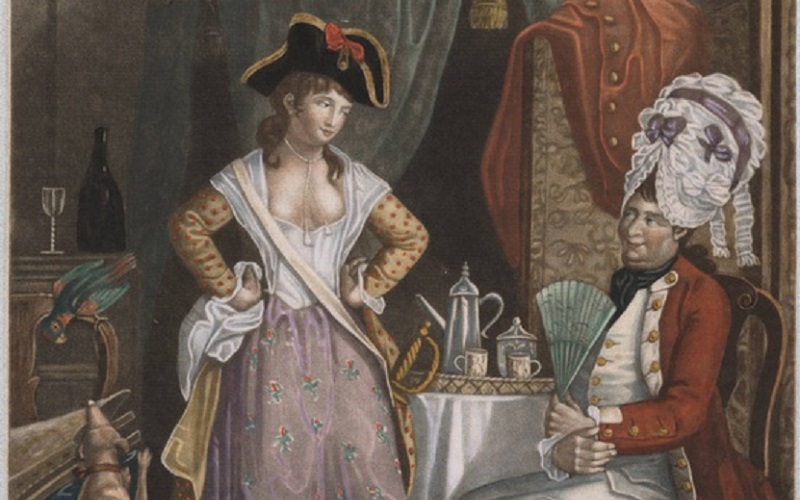One of the challenges of uncovering transgender histories is that even where we find stories which hint at trans identities, we can't go back and ask the individuals in question how they would describe themselves.
Even if we could, concepts of gender identity constantly shift and change throughout history, and the question would probably make very little sense to someone who lived centuries before us.
However, the hints we find show us that in the past, just like today, gender was not a simple binary.
Molly houses
In 18th century London a 'molly house' was a coffeehouse, inn, or tavern at which men could meet in secret to socialise and have sex. 'Molly' or 'moll' was a slang term for a gay man, and for a lower class woman, or a woman selling sex.
Although at this time in England sex between men was punishable by death, molly houses were part of a thriving gay subculture:
The legal records document investigations into about 30 molly houses during the course of the century. Considering that the population of London was only about 600,000 in the 1720s, having even just a dozen molly houses at that time is a bit like having 200 gay clubs in the 1970s. In some respects, the eighteenth-century molly subculture was as extensive as any modern gay subculture.
One of the main molly districts was on the east of the City, around Moorfields in Shoreditch. What is now the south side of Finsbury Square was a cruising area known as 'Sodomites' Walk'.
Cross dressing
Molly houses are a site where gay histories and trans histories intermingle. It was common for men at the molly house to wear women's clothes and to speak and act in typically 'feminine' ways. Most had alternative names such as Plump Nelly, Primrose Mary, Aunt May, Susan Guzzle, Aunt England, and the Duchess of Camomile.
One very famous molly called Princess Seraphina wore her feminine identity beyond these secret meeting places and into her public life. In 1732 she brought a case against a man for stealing her clothes. Her neighbour Mary Poplet described her in her testimony:
I have known her Highness a pretty while... I have seen her several times in Women's Cloaths, she commonly us'd to wear a white Gown, and a scarlet Cloak, with her Hair frizzled and curl'd all round her Forehead; and then she would so flutter her Fan, and make such fine Curt'sies, that you would not have known her from a Woman: She takes great Delight in Balls and Masquerades, and always chuses to appear at them in a Female Dress, that she may have the Satisfation of dancing with fine Gentlemen. Her Highness lives with Mr. Tull in Eagle-Court in the Strand, and calls him her Master, because she was Nurse to him and his Wife when they were both in a Salivation (salivation was a mercurial cure for syphilis); but the Princess is rather Mr. Tull's Friend, than his domestick Servant. I never heard that she had any other Name than the Princess Seraphina.
Raids on molly houses
Much of what we know about mollies comes from court proceedings following raids on molly houses, the most well known of which was the raid on Mother Clap's molly house in 1726, in Holborn. (Incidentally, Mother Clap was a real woman called Margaret Clap.) After the raid several people were tried and three men were hanged at Tyburn for the crime of 'sodomy'.
One of the best documented examples from east London is a raid on a molly house in Whitechapel.
"Nine male ladies" arrested
The molly house was owned by Miss Muff - also known as Jonathan Muff - and it stood in Black Lion Yard. The yard no longer exists, but Black Lion House now stands on the site at 45 Whitechapel Road.
On 5 October 1728 The Weekly Journal; or, British Gazetteer includes a news item about the raid:
On Sunday Night last a Constable with proper Assistants, searched the House of Jonathan Muff, alias Miss Muff, in Black-Lyon Yard, near Whitechapel Church, where they apprehended nine male Ladies, including the Man of the House. They were secured that Night in New Prison, and Monday Morning they were examined before Justice Jackson, in Ayliff-streeet; John Bleak Cawlend was committed to Newgate, he being charged on Oath with committing the detestable Sin of Sodomy.
Of the nine arrested we know that two were whipped, one was fined, two were acquitted, and one - whose name was given as Thomas Mitchell - attempted to end his life in prison:
he attempted, and had near accomplish’d, destroying himself, in cutting the great Artery of his Left Arm almost asunder; but by the immediate Help of some eminent Surgeons he was preserv’d, tho’ at the Point of Death thro’ the great Effusion of Blood.
Glimpsed histories
We can never know at this distance how individuals would define or describe their identities, especially when so much LGBTQ+ history is uncovered through documents produced by a hostile state and media: court records, medical diagnoses, and newspaper reports. What is clear is that both homophobia and transmisogyny have long roots.
It's also clear that throughout history many, many individuals have resisted those forces, sometimes risking everything to be true to themselves. It's up to us to try and tell their story when we find it, even if all we have are hints and glimpses.
Sources
- Rictor Norton (Ed.), "Newspaper Reports, 1728," Homosexuality in Eighteenth-Century England: A Sourcebook. 10 August 2002, updated 16 November 2011 http://www.rictornorton.co.uk/eighteen/1728news.htm
- Rictor Norton - The Georgian Underworld
- David Higgs - Queer sites: Gay urban histories since 1600
- Historic England - LGBTQ Heritage Project






